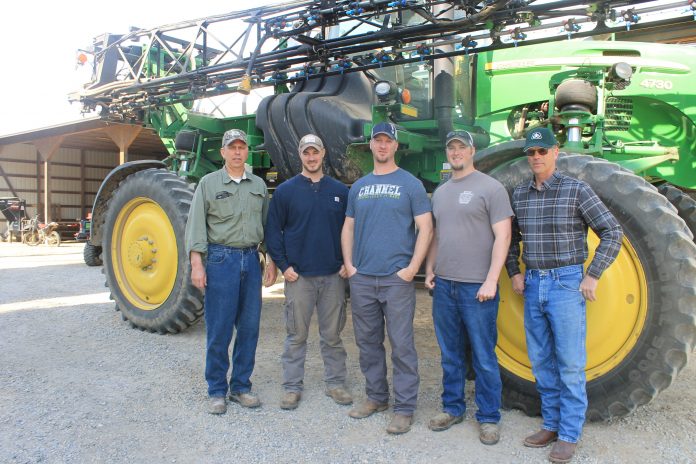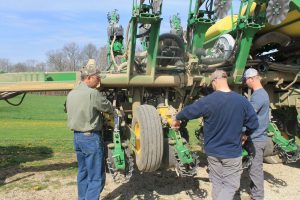
BOLIVAR, Ohio — “Technology spoils us,” said Eric Spillman, who farms 2,600 acres in Tuscarawas and Stark counties with nephews, David, Matt and Steven Spillman.
“We learn more about the technology every day we use it. The more data we put in, the more accurate and helpful it can be,” added David.
“If you know how to work it, it will save you money. It gives you the freedom to have a snack or turn in your seat to watch what is going on behind you.” Eric said of planting with GPS.
The Spillmans have been planting with GPS for eight years, and they keep getting better at using GPS and other farming technology, said Matt, 30, who always knew he wanted to be a farmer.

Being able to watch and stop at the first sight of a problem does save time and money, a big change since Eric and his brother Mark bought the 180-acre farm in 1981.
Now, among all of them, they own 600 acres and rent an additional 2,000.
“Usually a firm handshake and a gentlemen’s agreement works just fine,” said Eric about how he and Mark have worked with local landowners as they expanded.
“We treat it [the land] just as we would our own, and the landowners appreciate that,” Eric said.
Mark has struggled with dementia for five years. It has progressed now to a point that he isn’t able to help on the farm.
Their father’s battle with dementia brought David, 32, and Steven, 28, back to the farm, full time.
David attended Ohio State’s Agricultural Technical Institute and was a seed salesman and Steven went to Ohio University where he majored in environmental policy management, and was a crop insurance adjuster.
David has been working at the farm now for several years and Steven started full time at the farm about a year ago.
He always knew this is where he wanted to be, just not this soon, Steven said, but the farm needed him, since they don’t hire outside help.
“We are pretty particular,” Matt said. “I like to do my own work; if it’s screwed up, it’s your own fault.

Matt is the chief sprayer and has his commercial applicator’s license. He operated a custom spraying business for four years, but it got to be too many long hours, so now he sprays only for their farm, he said.
Climate Fieldview
Each morning, once their family obligations are taken care, of the men gather at the farm. Sometimes they need to talk through the day’s activities and other times they all know what needs to be done and jump right in.
They use Climate Fieldview, an app they all have on their phones and tablets, to keep records of their fields. They are able to save notes and comments, keeping them all on the same page.
The app tracks rainfall, nitrogen, variable rate seeding and fertilizer and projects a yield goal based on sunlight, water, soil type and other factors.
It collects the information into one place and creates a variable rate prescription for the inputs of each field.
For two years, they have been using field health imagery available within the app. They can see hills and places where the crop’s stand isn’t as healthy. The maps help the farmers monitor growth and crop health, narrowing down where to scout. This allows them to address problems sooner, David said.
“It shows us how much money we’ve lost,” Matt said, about being able to see yield maps.
The information also suggests, for example, where a grass buffer could be helpful to decrease runoff, or to eliminate tree cover and ultimately increase profits.
“We do good managing inputs with hopes of better yields,” Eric said.
Making crops profitable
They plant mostly corn and soybeans but also put in 150-250 acres of wheat, and 100-150 in hay, depending on the year.
They work hard to find the best market for their grain. This year they have most of their beans under contract and are selling their corn to Case Farms, Eric said.
They have worked with Bunge in Bellevue, and Deerfield Farms in Massillon to fill ship containers, and always keep their eyes open for grain marketing opportunities.
On the farm, they have 160,00 bushels of storage, which helps them sell when the time is right.
The Spillmans usually have contracted their grain and bought their inputs before year-end.
Eric isn’t concerned yet about the recent trade discussions impacting his bottom line, but said, “what America has to offer is agriculture.” So, he will keep watching in hopes the markets will swing in America’s favor.

Farm strategies
They use a vertical drill and no-till some corn. They’ve had issues with too much residue, which has disrupted an even emergence, Eric said about the need for the vertical drill.
They use cover crops, mostly cereal rye or a cover crop mix, on hillsides.
“We hope to see the long-term benefit, and it feels like the right thing to do,“ Eric said.
They kill the cover before planting, as they worry the cover could dry the soil out too much in their sand and gravel ground.
“We pray for rain to fall every week in July and August around here,” he said.
Advancing the industry
They also participate in field plot studies, and this year they planted a seed population plot. In the study, Ohio State University Extension will evaluate the results after the Spillmans have planted various amounts of seeds per acre. They will be calculating yields versus input costs.
Each year they have 10-30 acres in research, depending on what field they use. Their goal is to help the seed industry progress.
Looking to their farm’s future, they talk about growing by several hundred acres of rented or purchased land, but they often come up against urban sprawl and land prices as they look to expand, Eric said.
“When people say we are too big, I say look around — we are average,” he said. “(We are) just trying to do the best we can with what we have.”
“We have to keep with the times or fail,” Eric said.











